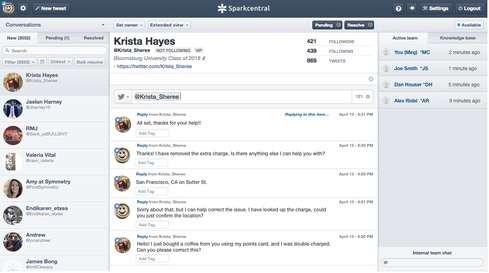T-Mobile, Sparkcentral Slash Social Media Response Time
Social media expectations are rising. T-Mobile and Sparkcentral believe they have a better, faster way to communicate with customers.


9 Spectacular Cloud Computing Fails
9 Spectacular Cloud Computing Fails (Click image for larger view and slideshow.)
Customer expectations are more demanding than ever. At the same time, the number of potential channels enterprises need to engage customers is increasing. Many contact centers are struggling to keep up, but T-Mobile's partnership with Sparkcentral might serve as a potential blueprint for improving your social media response times.
In the course of a single day with a new engagement platform by Sparkcentral, T-Mobile completely eliminated its social media response queue. It also reduced response time from over two hours to under 10 minutes.
The kind of ROI both in terms of staff efficiency and in brand satisfaction is obvious.
Sparkcentral, of course, blames outdated and ponderous legacy systems for the problems that enterprises are having dealing with social media.
In an interview with InformationWeek, Sparkcentral CEO Davy Kestens, said, "If you look at enterprise customer service software, you have giant players like SAP and Oracle, and you look at their evolution over time there was phone, and then email, and then SMS. As new forms of communciation popped up, they acquired businesses and added on capabilities to handle those communications. But what is happening now is that we are in a world where unified communications is just not working well."
Kestens said that basically a "redo" was necessary, because we'd gotten away from thinking about the way representatives really interact with customers.
Social Media as Game Changer
Social media doesn't work like the phone, Kestens notes.
Customers engage with their family and friends over social media and get nearly an instant response. They expect the same thing from the companies they engage on social media.
"I'm sure you are used to engaging with a company," Kestens said, "and you have to keep retelling your story to each new representative. From a customer service point of view, the systems are broken."
Whether you agree with the assessment of Sparkcentral's competitors or not, T-Mobile had a problem it needed to fix.
T-Mobile social media services director Michelle Mattson had two major issues, one with customer interaction and one with planning. "Our main pain point was not being able to see a conversation that happens on social media," she said, "If a customer tweeted us five times and we responded, it was a ticket-based point of view, so we had five tickets and we had to merge all the tickets."
Now, instead, T-Mobile's representatives can read an entire conversation on the screen.
Instead of a bunch of isolated responses, a single representative "owns" the conversation from start to finish. According to Mattson, talking to T-Mobile will be "a lot faster and it will be a lot more seamless. If we ask you for your information, we won't ask you in plain text. We're going to stay on channel with you and do it securely."
It was important to Mattson that she engage the customer where they engage her brand. In the past, if a customer reached out via Twitter, representatives would ask for responses via email. Customers were put off and sometimes confused by being forced to move to a different communication style.
"We believe in meeting you where you want to meet," Mattson added.
The other issue T-Mobile had was with planning and forecasting, because it simply didn't have the data it needed regarding customer interactions.
"We were lacking reporting capabilities. I couldn't tell you my volumes," Mattson said. "If you look at forecasting and planning, this is crucial. We couldn't get CRT (customer response time). In order to forecast well you need volume and CRT."
Once T-Mobile knew its response times and volume it was able to see it needed to grow its social media response staff. More importantly, it was able to staff and forecast correctly.

Sparkcentral's response time report.
Even without that staff, simplifying the communication and putting interactions in one space allowed T-Mobile to clear its communication queue the night before the iPhone 6 would flood them with new requests. On that day they were able to reduce response time significantly.
"It took a lot of the pain away for representatives," Mattson said, "It used to take 10 or 12 clicks before being able to help a customer. When we started [the new system] I was in the room, and there were literally tears of joy."
Dealing With Legacy Systems
According to Kestens, "This is a problem a lot of enterprises have, but underestimate. There are so many software solutions that are old and clunky that enterprises are using, and they are a drain on the enterprise." Kestens thinks it is all about expectations management.
"Over the last 30 to 40 years there hasn't been a need for expectation management. Call centers were just something you dealt with as a customer," Kestens said. "But imagine if you send a tweet and got a response that said, 'We only respond from x hour to x hour.' You’d be annoyed. It is not necessarily about being in first or second place with customer service, but will you be able to handle the growth in expectation? Some enterprise will go from the top to below the status quo."
[In fact, customers would rather go to the dentist than call customer support. Read Millennials: Why Customer Service Will Never Be the Same.]
To be prepared, you need to ask yourself some very important questions:
Is your customer service software prepared to handle social media?
Can your software handle communications across multiple channels? If a customer calls and tweets you, will you recognize that as a single interaction instead of two?
Can your software handle conversations so that your customer doesn't have to re-explain everything at each interaction?
Can you handle reporting so you know your needs, staff accordingly, and hire mitigation staff when necessary?
Can you meet the growing increased expectations of customers across multiple channels of communication?
If you said yes, then congratulations. Whatever vendor you've chosen, you are ready for the growing demands of customer service. If you said no to any of them, you might need to rethink what you are doing, because the expectations of your customers are growing.
About the Author(s)
You May Also Like
How to Amplify DevOps with DevSecOps
May 22, 2024Generative AI: Use Cases and Risks in 2024
May 29, 2024Smart Service Management
June 4, 2024







